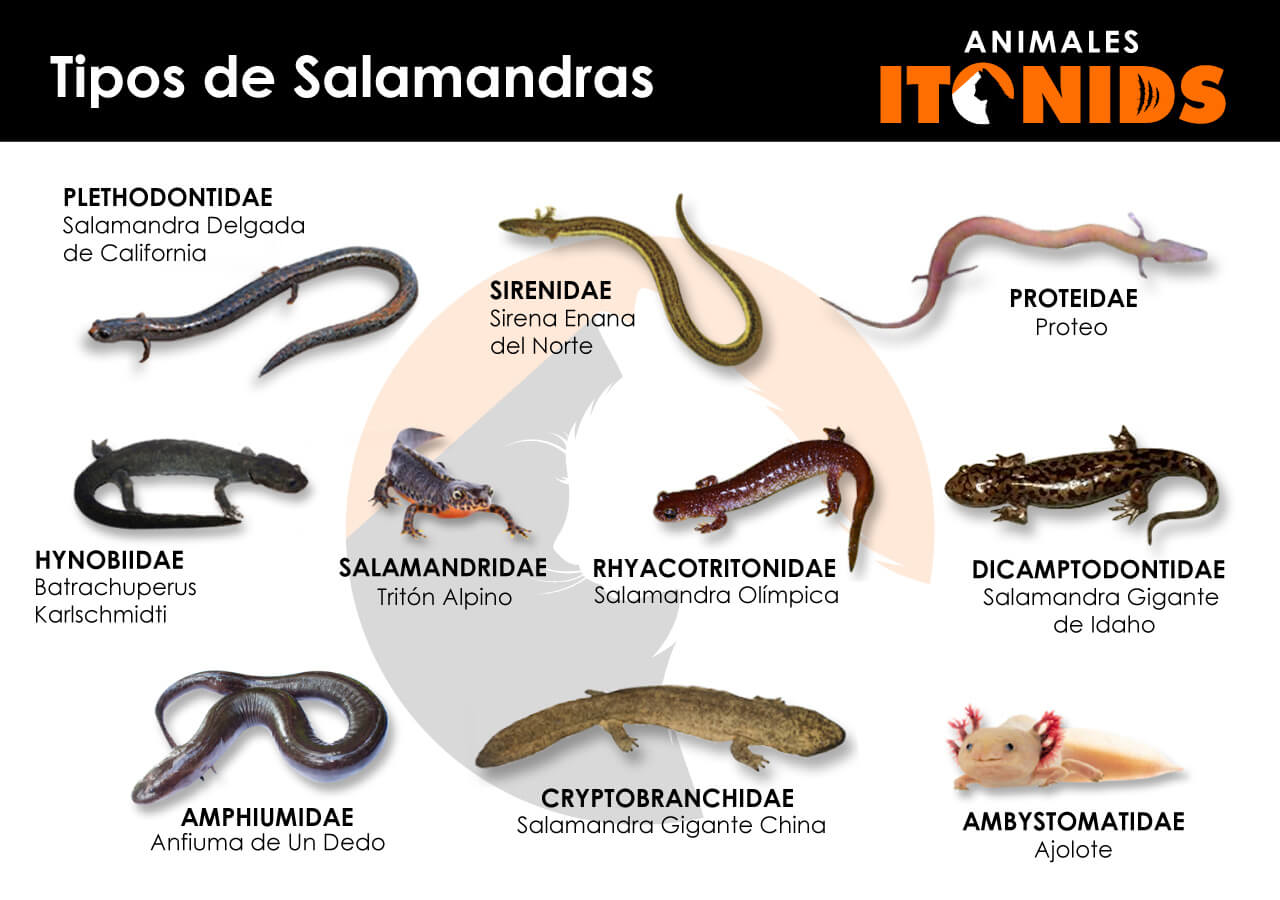When asked which animal family the salamander belongs to, on more than one occasion, the answer has been reptiles, due to their resemblance to lizards and their way of walking.
However, their closest relatives are toads and frogs! belonging to the “amphibians.”
Whether submerged in water, or in damp places on land, it is possible to find some of the 695 living species of “salamanders,” defined by the name of their order “Caudata, “with tail””, and easy to recognize by the color of their “black skin with yellow spots.”
Sirens, newts, and giant salamanders are just a few of them, owners of an admirable regenerative capacity and considered since ancient times as fantastic beings, “capable of mastering the element of fire” with their supernatural power.
Let’s take a look at some of the characteristics of this exotic animal, full of attributes and mystery! Discover the types of salamanders that exist and several interesting facts about it.
What is the salamander?
The salamander is a urodele amphibian, from the Greek “ourá, “tail” and delos, “visible””, that is, equipped with a tail, a long body, and short legs, of varying colors and sizes, with the ability to inhabit both aquatic and terrestrial zones.
The common name “salamander” refers to a divine creature forged from heavens and hells, capable of walking through fire, and coming out unscathed.
Salamanders are descendants of the first vertebrates (animals with a spinal column) that emerged from the waters, and according to a recent fossil discovery made in China, they are estimated to have inhabited the earth for 160 million years.
Which group does the salamander belong to?
The “salamanders” belong to the “Group or Phylum “Chordates” (Chordata), from the Greek ‘khordota’, that is, with cord” indicating the presence of a cord (spinal column).
In turn, they belong to the Subphylum (subgroup) “Vertebrata, “vertebrate””, “Class Amphibia, “amphibians”, from the Greek ‘amphi’, both and ‘bios’, life” describing their capacity to lead a double life (aquatic and terrestrial).
Finally, they are classified within the Order “Caudata, “with tail””, and the current species are distributed in ten families.
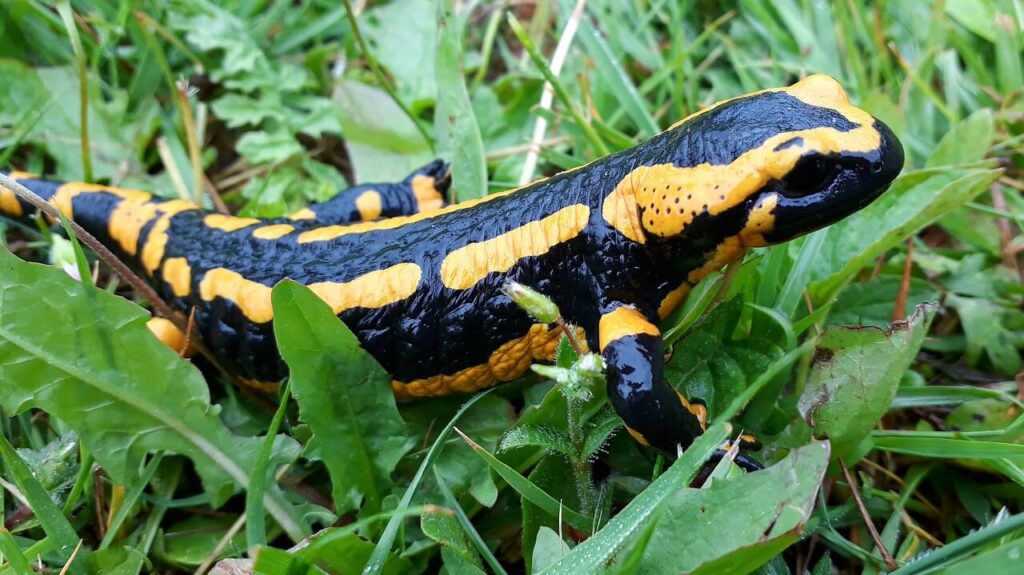
Characteristics of the Salamander
- Long body, snout, and somewhat flattened head. Normally, the female is larger than the male.
- Large, bulging, black eyes.
- Long and sticky tongue.
- Most species have small teeth.
- Four short, thick, symmetrical legs; commonly with four toes on the front legs and five on the rear legs, and they adapt according to their habitat (elongated toes for climbers and short for those that live on rocks).
- Some aquatic species (sirens and amphiumas) have reduced or eliminated their hind limbs (adopting the appearance of an eel).
- Broad tail, and thin towards the tip, useful for balancing its weight, clinging to branches and trees, jumping, and propelling. Moreover, the tail is used in courtship and as a defense mechanism, detaching from its body when threatened!
- Coordinated movement, the right upper leg moves along with the lower left (and vice versa), accompanied by the swinging of its spinal column.
- Variable size, commonly between 12 and 30 centimeters.
- Nocturnal habits, avoiding direct sunlight.
- Moist, porous, and soft to the touch skin, without scales (except for newts, which may have rough skin), covered in mucus, a substance favorable for maintaining its moisture and when swimming.
- Black shiny skin color, combined with vivid colors (yellow, orange, red) in the form of spots, dots, stripes, and bands, which serve as warning signals to their predators and to attract the female during courtship.
- Species that live in caves lack pigmentation, and their skin adopts a pale pink or transparent color.
- Incredible regeneration capacity, they can repair their heart, brain, and spine, and grow a complete limb!
- Certain species can secrete venom (called tetrodotoxin) from their skin glands, which acts as an irritant and tastes bad, as well as pheromones (which indicate their sexual availability in courtship).
Did you know…? The common salamander (Salamandra salamandra) has a crest on its back that contains venomous glands, and it tilts its body to direct a stream of toxic liquid at its attacker, up to a distance of 80 centimeters.
Nervous System
The salamander has a central nervous system; its brain is connected to two sensory areas (olfactory epithelium and vomeronasal organs) that pick up smells and detect chemical signals (pheromones).
Senses
Well-developed organs of sight and smell, distinguishes colors and is adapted to night vision; some species are blind or their eyes are covered by skin (the blind salamander of Georgia).
At the level of touch, salamanders have mechanical receptors in their skin, sensitive to changes in temperature, pollution, and movement.
Taste is associated with the detection of chemical signals and they have two inner ears, capable of detecting low-frequency vibrations (500-600 Hz). Certain species can hear through the vibration of their lungs.
Did you know…? Despite being considered mute, salamanders can generate a sound through their nose (tick) or by using the muscles in their throat (snap) possibly to confuse their predator.
Respiratory System
In most cases, aquatic salamanders breathe through external gills (like feathers or tufts) on the sides of their head, certain species do it through lungs (small sacs), and some possess both lungs and gills.
In terrestrial species, gas exchange occurs through the skin and the mouth tissues.
Circulatory System
Salamanders have a double circulatory system (two circuits): one that drives the blood pumped by the heart to the respiratory organs, and another that carries the blood from the respiratory organ to each organ, through a dense network of blood vessels beneath the skin.
Muscular System
Composed of smooth, striated, and cardiac muscles, joined by connective tissue (which supports and protects the body’s organs), and determine movements (voluntary and involuntary).
Digestive System
The digestive system of salamanders is simple, formed by the mouth, the esophagus leading to the stomach (elongated shape), and an intestine (straight tube) that ends in the cloaca (opening for eliminating waste, urinating, and conduit for reproduction).
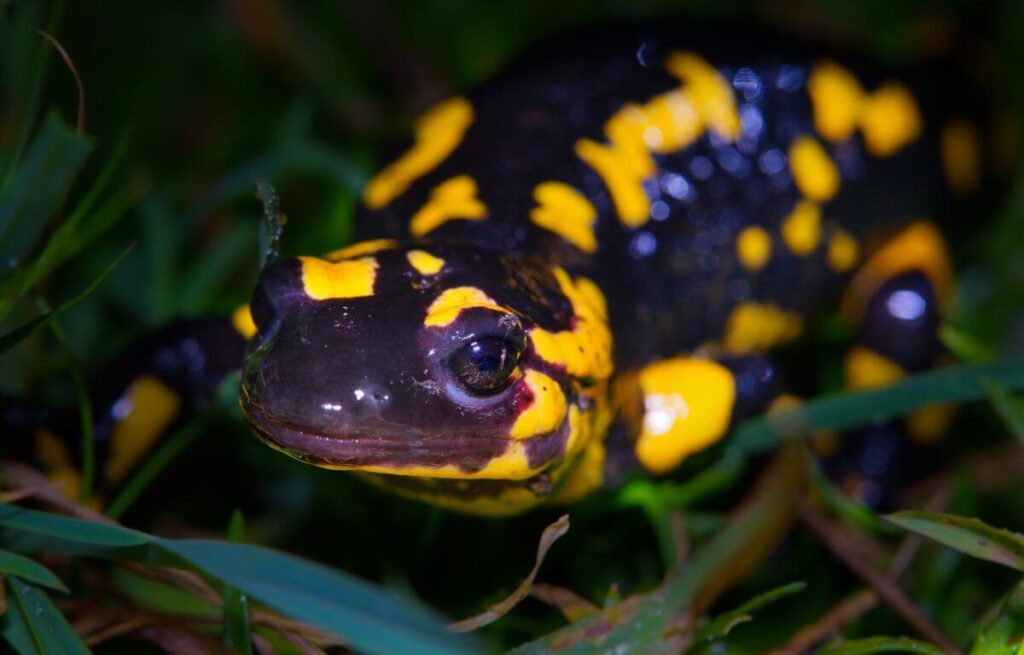
Reproductive System
The male possesses male organs (testicles) and the female, female organs (ovaries), in the form of small sacs.
How do salamanders reproduce?
Mating is nocturnal and almost all species reproduce by internal fertilization.
It occurs when the male places a spermatophore (gelatinous sac containing sperm) near the water (or in the water) and if the female accepts it, she will pick it up, to store it in a reservoir (spermatheca), and can retain it for more than a year!
Once fertilized, the female salamander releases the eggs in the water (ovoviviparous reproduction), and upon breaking, an aquatic larva is born, which develops into an adult (aquatic or terrestrial) through metamorphosis (changes in life cycles).
There are species that have viviparous reproduction (for fully transformed larvae).
In the most primitive salamanders, external fertilization occurs when the male emits the spermatophore over a mass of eggs.
Did you know…? During courtship, the Common Newt (Triturus vulgaris) male makes his tail vibrate against his body and hits himself with it, so that the female turns to look at him.
Where do salamanders live?
Salamanders inhabit damp and shady areas, surrounded by vegetation (swamps, streams, lakes…), in mountainous areas (near rivers, ponds) hidden among logs, moss, leaves, or in coastal zones. They can also be found in mines and caves.
They are widely distributed in North America (about 33% of the total species) especially in the Appalachian Mountains region, in Europe, Asia, North Africa…and a few species in South America.
Did you know…? In the year 2020, scientists from Hungary discovered a rare species of cave salamander (Proteus anguinus) that has remained immobile in the same place for 7 years without moving an inch!
Lifespan of a Salamander
Generally, the estimated lifespan of a salamander is between 25 and 30 years, certain species (giant salamander) can reach a lifespan of 80 years in the wild and 55 years in captivity.
What Do Salamanders Eat?
Salamanders are carnivorous and prefer insects and small animals as food (crustaceans, insect larvae, annelids such as earthworms, worms, and arachnids).
For capturing their prey, the terrestrial salamander launches its long sticky tongue, securing its attack in less than half a second!
Aquatic species are excellent swimmers and use their mouths and teeth for hunting, consuming small fish, tadpoles, leeches, mosquito eggs…
In ephemeral waters (only has water when it rains), it is possible that salamander tadpoles may eat each other; and adults of the black-bellied salamanders can devour other salamander species.
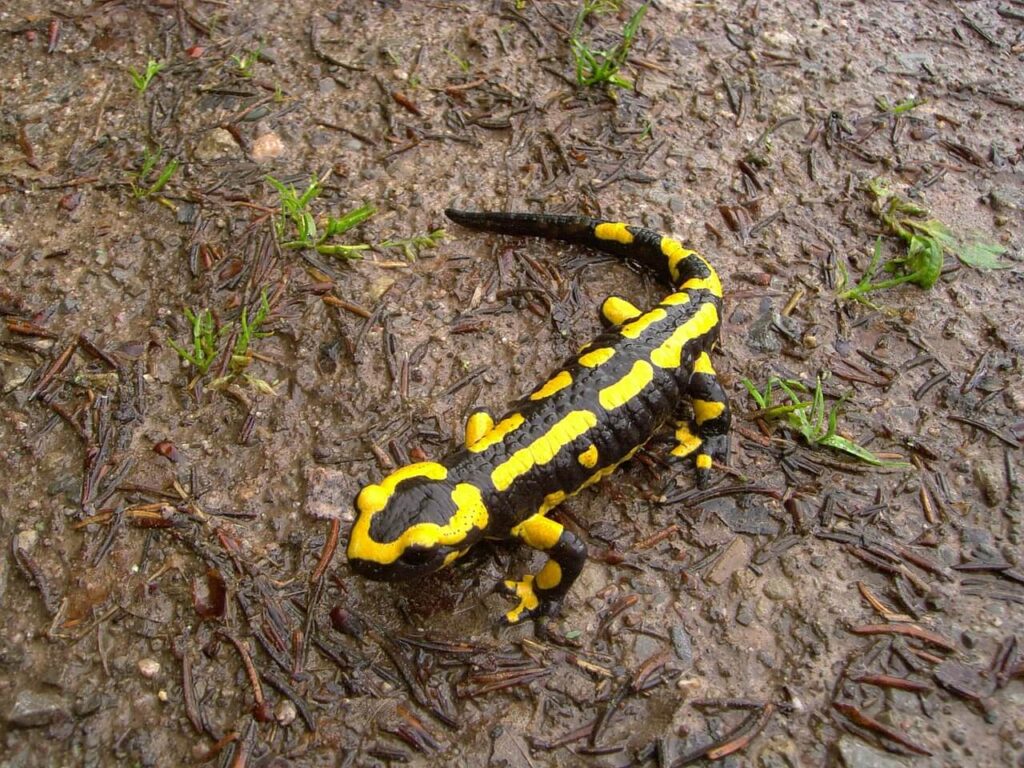
Types of Salamanders
There are about 695 living species of salamanders, organized into ten families.
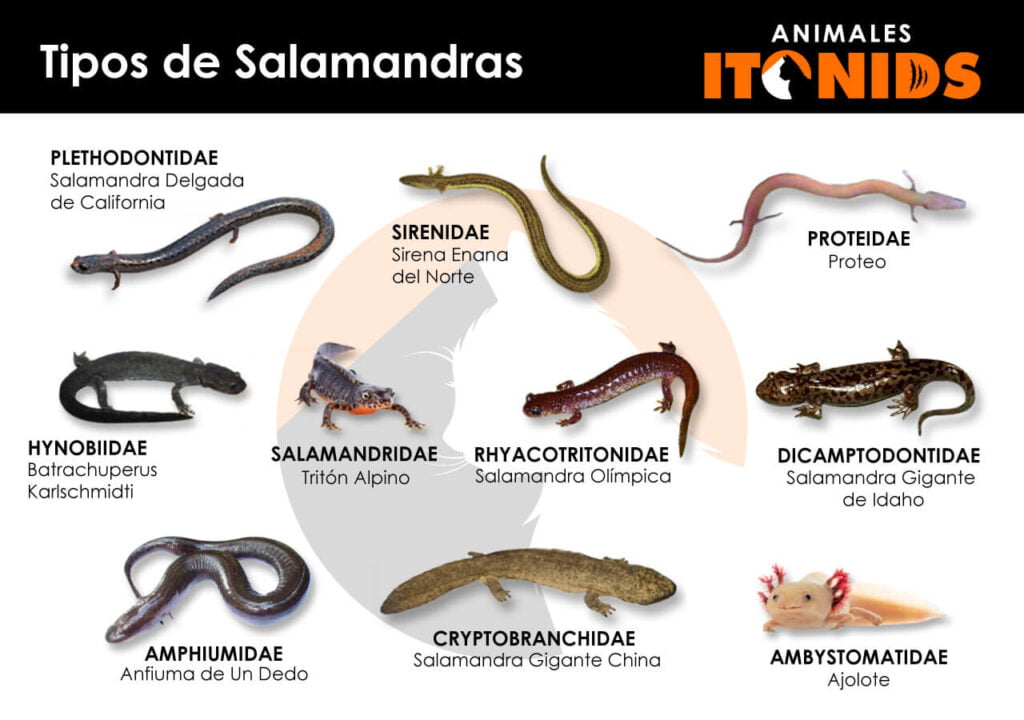
Plethodontidae
Includes 440 species, mostly distributed in the American continent, and they do not have lungs, so they breathe through their skin and mouth tissues.
Specimens
California Slender Salamander (Batrachoseps attenuatus), Korean Crevice Salamander (Karsenia coreana)…
Salamandridae
It has two well-differentiated groups: Newts (87 species) semi-aquatic salamanders (alternating between aquatic and terrestrial habitats), with webbed feet and a paddle-shaped tail; and terrestrial salamanders (18 species).
Specimens
Alpine Newt (Ichthyosaura alpestris), Common Salamander (Salamandra salamandra)…
Hynobiidae
Also known as Asian salamanders, includes 60 species.
Specimens
Afghanodon mustersi, Batrachuperus karlschmidti…
Sirenidae
Contains 4 species of salamanders, with elongated bodies and developed tails with only two limbs (hind limbs absent), adapted to aquatic life.
Specimens
Northern Dwarf Siren (Pseudobranchus striatus), Greater Siren (Siren lacertina)…
Amphiumidae
Only found in the United States and includes 3 species, differentiated by the number of toes on their limbs; they have an aquatic life and are characterized by being large in size.
Specimens
Three-toed Amphiuma (Amphiuma tridactylum), Two-toed Amphiuma (Amphiuma means), and One-toed Amphiuma (Amphiuma pholeter).
Ambystomatidae
Also called mole salamanders, common in caves and underground places, and includes 37 species.
Specimens
Axolotl (Ambystoma mexicanum), Thin-skinned Salamander (Ambystoma bombypellum)…
Did you know…? The “axolotl (Ambystoma mexicanum)” is capable of regenerating the part of the spinal cord affected by an injury, an incredible act that scientists want to apply in humans!
Rhyacotritonidae
They are found in coastal forest mountains and encompass 4 species.
Specimens
Olympic Salamander (Rhyacotriton olympicus), Cascade Torrent Salamander (Rhyacotriton kezeri)…
Proteidae
Includes 6 entirely aquatic species commonly found in caves.
Specimens
Olm, Proteus anguinus, Mudpuppy (Necturus maculosus)…
Cryptobranchidae
Gathers giant salamanders, grouping 3 species located in China, Japan, and the United States, with sizes varying between 70 centimeters and 1.80 meters.
Specimens
Chinese Giant Salamander (Andrias davidianus), Japanese Giant Salamander (Andrias japonicus), and the Hellbender (Cryptobranchus alleganiensis).
Did you know…? The “Chinese Giant Salamander (Andrias davidianus)” was considered the largest amphibian (1.80 meters); however, a recent discovery highlights that the position is now held by its cousin, “Andrias ligoi” with 2 meters in length!
Dicamptodontidae
This family was included in 2006 as part of the Ambystomatidae (still under discussion), including 4 large species.
Specimens
Idaho Giant Salamander (Dicamptodon aterrimus), California Giant Salamander (Dicamptodon ensatus), Cope’s Giant Salamander (Dicamptodon copei), and the Pacific Giant Salamander (Dicamptodon tenebrosus).
Salamander and Its Spiritual Meaning
Various cultures have defined the salamander as a fantastic being, of great spiritual significance, linked to one of the four elements, fire.
Represented as a creature half dragon, half lizard, surrounded by flames, it is part of great stories, like that of the conqueror Alexander the Great and how they ended an entire army thanks to the poison of the salamanders and their great power.
Figures such as Leonardo Da Vinci claimed that the salamander fed on fire.
Thus, it became a symbol of spiritual energy, capable of balancing the heat of fire and freeing itself from the flames of temptation without being harmed, and associated with the movement of volcanoes, able to regenerate nature and all existing forms of life.
And all thanks to the moisture of its skin! which can protect it for a few seconds from the flames, and allow it to escape.

